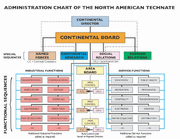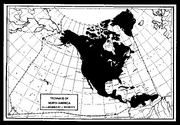The new group sought to implement the findings of the Alliance and create a new kind of society based on energy accounting instead
Technocracy Inc. organised a large demonstration in 1947 but its membership began to decline after the war years. Scott remained as it leader and chief engineer until his death in 1970. The organisation still exists today and has its HQ in Ferndale, WA, USA.
Today as they have done continuously since their inception, this groups members partake in discussion groups, publish quarterly magazines, and advocate for the original concepts of a Thermoeconomics based scientific social design. They also publish a monthly newsletter called Trend Events.[1]
Ideas and goals[]

Trends of the price system with technologic escalation.

A diagram of the Technical Administration of the North American Technate showing the Functional sequences and their relationship to one another.
One thermodynamic interpretation originated in the works of Frederick Soddy. Frederick Soddy winner of the Nobel Prize for chemistry in 1921, published Wealth, Virtual Wealth and Debt (George Allen & Unwin 1926), which is used as a reference in the Technocracy Study Course. In Wealth, Virtual Wealth and Debt, Soddy turned his attention to the role of energy in economic systems. He criticized the focus on monetary flows in economics, arguing that “real” wealth was derived from the use of energy to transform materials into physical goods and services. Soddy’s economic writings were largely ignored in his time but viewed highly by Technocracy related groups. His ideas would later be applied to the development of biophysical economics and ecological economics and also bioeconomics in the late 20th century.[2]
Views of the price system[]
The term "price system" is an economic term used by Technocracy Incorporated to describe any economic system whatsoever that effects its distribution of goods and services by means of a system of trade or commerce based on commodity valuation and employing any form of debt tokens, or money and which attempts to balance supply and demand of scarce resources. Except for possible remote and primitive communities, all modern societies use price systems to allocate resources. TechInc advocates a non price system method.[3]
Technocracy Incorporated proposed and purposes, a non monetary system of Energy Accounting[4] which uses a post scarcity type of economy as its basis. The technate design as projected, would include such post scarcity aspects as free housing (urbanates), transportation, recreation, and education. In other words, free everything, including all consumer products, as a right of citizenship.[5]
Technocracy Incorporated aims to establish a zero growth socio-economic science based system, predicated upon conservation and abundance as opposed to scarcity-based economic systems like capitalism or the so called planned economic system (within a Price System) used by Communist states.
The organisation argues that developments in mechanisation have caused a massive shift of employment towards the service sector and that money creation and distribution jobs such as banking, insurance, etc. could be eliminated with the use of energy accounting.[6] Further increases in efficiency and productivity mean that most of the tasks performed by human employees could be reduced or eliminated through better management, automation, and centralization. These trends could signal an increase in both production possibilities and leisure time since more can be produced with less human labour and many money related and service related jobs could thus be eliminated. Within a market system, however, increased productivity often leads to downsizing because companies need fewer workers, and also lower wages because of job competition. These conditions reduce purchasing power in a price system, which makes that system ultimately untenable in a technological society, or so goes that argument.
==
The North American Technate[]

Map of the North American Technate by TechInc.
The North American technate is a design and plan to transform North America into a technocratic society. The plan includes using Canada's rich deposits of minerals and hydro-electric power as a complement to the United States's industrial and agricultural capacity (Many of the details of this plan are presented in the Technocracy Study Course).
The North America Technate would be composed of all of North America, Central America, the Caribbean, parts of South America and Greenland, encompassing some 30 modern nations (as well as numerous Non-Self-Governing Territories). If the Technate were set up today, it would contain nearly 600 million citizens and its total land area would be over 26 million square km (making it the largest nation on Earth). Its territorial claims would stretch from the North Pole in the north, to the Equator in the south and from the Caribbean in the east, to the International Date Line in the Pacific Ocean, to the west.
Urbanates: A technocratic replacement for cities[]
Once a technate has been established Technocracy Incorporated advocates a form of living environment called Urbanates. An Urbanate is essentially an assembly of buildings where people live and work. These places would have all the facilities needed for a community, including schools, hospitals, shopping malls, waste management and recycling facilities, sports centres, and public areas.
Technocrats plan for Urbanates to be something akin to resorts, designed to give each citizen the highest standard of living possible. Getting around in an Urbanate would be inherently easy and efficient.[7]
Urbanates would be connected via a continent-wide transportation network envisioned by Technocracy, which would involve a High-speed rail network linking every Urbanate, the Continental Hydrology (a Canal network), and air transport. These systems would also be connected to the Technate's industrial sites for easy transport of goods to consumers, and to all recreational and vacation areas of the continent.
The reason given by Technate advocates for all this ambitious restructuring of urban life is that modern cities are often extremely poorly planned and built in a haphazard way leading to major inefficiencies, waste, and environmental problems. Technocrats propose that rather than trying to solve these problems within the framework of existing cities based on current economic or price system agendas, new living constructs would reflect new values in a non monetary system.
Technocracy Incorporated Publications[]
The organization has published several magazines throughout its history, including the The Technocrat, The Northwest Technocrat and Technocracy Digest, it currently publishes the North American Technocrat[8] and a monthly Trend Events newsletter (for a more complete list of past publications see here [1]).
- Technocracy Study Course [Technocracy, Inc.] (1934)
- Continentalism: The Mandate of Survival, (1947)
- Many essay publications from the 1930's to the present available in the archive links below.
- Trend Events... a monthly publication. Here is an example.. http://www.technocracy.org/Trendevents/June_2008_TRENDEVENTS%5B1%5D%5B2%5D%5B2%5D.pdf
External links[]
- Technocracy Incorporated (Official Website)
- Historical Background and Development of Social Security from the U.S. Social Security Administration (see section Technocracy)
- Archive material from Technocracy Incorporated
- History and Purpose of Technocracy according to Howard Scott
- The Technocrats 1919-1967: A Case Study Of Conflict In A Social Movement, David Adair
- The Origins of Technocracy from the official site
- The Energy Certificate
- A Place To Live In. Wilton Ivie Technocracy Digest Nov.1955.
- Economy and Thermodynamics: Borisas Cimbleris (1998)
- Article Topic: ecological economics - Encyclopedia of Earth
Bold text
See also[]
- Technocracy (bureaucratic)
- Technocracy
- Technical Alliance
- M. King Hubbert
- Technocracy movement
- Willard Gibbs
- Howard Scott
- Urbanate
- Frederick Soddy
- Thermoeconomics
- Econophysics
References[]
- ↑ http://www.technocracy.org/Trendevents/June_2008_TRENDEVENTS%5B1%5D%5B2%5D%5B2%5D.pdf
- ↑ http://www.eoearth.org/article/Soddy,_Frederick Soddy, Frederick - Encyclopedia of Earth
- ↑ Cutler J. Cleveland, "Biophysical economics", Encyclopedia of Earth, Last updated: September 14, 2006.
- ↑ Cite error: Invalid
<ref>tag; no text was provided for refs namedautogenerated7 - ↑ Cite error: Invalid
<ref>tag; no text was provided for refs namedautogenerated6 - ↑ Template:Cite book
- ↑ Ivie, Wilton A Place to Live: 1955 Technocracy Digest
- ↑ Template:Cite web
1. ↑ Akin, William E. (1977). Technocracy and the American Dream: The Technocrat Movement, 1900-1941. University of California Press. ISBN 0-520-03110-5.
2. ↑ Elsner, jr., Henry (1967). The Technocrats: Prophets of Automation. Syracuse University.